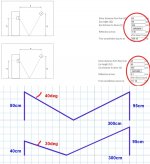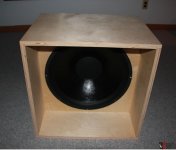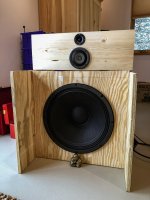The OB to dipole journey is an interesting one. I imagine many start with OB thinking it's a simple solution to a number of cabinet issues, and it is. They look into it more and discover ideally they need dipole radiation (how true is this?) and quickly discover it's anything but a simple thing to achieve.
The OB to dipole journey is an interesting one. I imagine many start with OB thinking it's a simple solution to a number of cabinet issues, and it is. They look into it more and discover ideally they need dipole radiation (how true is this?) and quickly discover it's anything but a simple thing to achieve.
The goal is for all reflections going to the room to be the same as the on axis response, for 360 degrees around the loudspeaker.
It gets lower in volume as you move off axis toward the null, but the frequency response is the same, and because most of what you hear is the room, the tonal balance is consistent.
Still about floor reflections...
Dipole response will be substantially lower only at 60 deg or more off-axis. Here sims with listening distance of 3 meters and rough estimate of angles when radiator is at 40 or 80 cm height. Tilting of the mid is a way ot enhance reflection minimization - Jorma Salmi was a smart guy!
Looking at this explains the 3 way with woofer closer to the floor concept.
Cross the mid at 300hz or slightly above to minimize or eliminate it's floor bounce.
Lower the woofer enough that it's working well under the frequency of it's floor bounce.
But from my understanding, the floor bounce seems to mainly affect the midrange (i.e. 300+ Hz).
Therefore, in a 3-way system, the woofer is placed close to the floor for LF reinforcements, and the midrange is above the latter, and hopefully higher than the aforementioned 40 cm, which should be sufficient to be above the 60 degree off-axis for floor bounce, unless I totally missed something on the subject!?!
Therefore, in a 3-way system, the woofer is placed close to the floor for LF reinforcements, and the midrange is above the latter, and hopefully higher than the aforementioned 40 cm, which should be sufficient to be above the 60 degree off-axis for floor bounce, unless I totally missed something on the subject!?!
Yes, constant directivity, but for that to be important doesn't the room have to reflect all frequencies equally?The goal is for all reflections going to the room to be the same as the on axis response, for 360 degrees around the loudspeaker.
It gets lower in volume as you move off axis toward the null, but the frequency response is the same, and because most of what you hear is the room, the tonal balance is consistent.
When I made that post I surmised that Juhazi's sim would come through with the quote, but it did not.
This is what I was referring to...with the mid at 80cm bounce is around ~300hz and at 40cm it's pushed up to ~700 range.
I've seen many designs that go three way, lower the woofer, and cross the mid above where it's bounce is located, while the lowered woofer is operated below where it's bounce is located.
This is what I was referring to...with the mid at 80cm bounce is around ~300hz and at 40cm it's pushed up to ~700 range.
I've seen many designs that go three way, lower the woofer, and cross the mid above where it's bounce is located, while the lowered woofer is operated below where it's bounce is located.
Attachments
I see that now, the higher you go with the driver in relation to the listener, the lower the frequency null caused by the floor bounce get, hence get the driver high enough that the null is outside of the selected frequency range (i.e. crossover points) of said driver.
This being said, where can I find the calculation formulas behind that schematic you attached? I am now curious about the placement of the drivers in the 4-way layout I'm currently planning.
This being said, where can I find the calculation formulas behind that schematic you attached? I am now curious about the placement of the drivers in the 4-way layout I'm currently planning.
Last edited:
Yes, constant directivity, but for that to be important doesn't the room have to reflect all frequencies equally?
With a dipole, the off axis nulls mean that a third less power is being put to the room. The most problematic area for room modes in your average sized domestic listening space is between 200hz and 50hz.
You're trying to take the room out of the equation as much as possible and actually, a lively room sounds better.
You definitely don't want a speaker where you walk behind it and everything above 600hz disappears. Or a speaker where you stand at the side, and have a dipole null in the bass, but the midrange is just as loud as on axis. You will notice uneven response, especially once you've heard a good omni or dipole set up with the same room as a speaker with uneven polar radiation.
We may not be able to design a speaker for each particular room, but with modern dsp and a good dipole or omni, if someone uses room correction...say they buy an amp that has audyssey or something similar...a system like that can be tuned to the room much better than one that does not have consistent response for 360 degrees.
The room is going to affect the sound of every speaker that's put in it, and it's the best solution I've found so far. Of course, the lack of stored energy and box resonance coming back out through the cone is the other major plus you can't get any other way.
Pluto style (lx mini whatev) omni is close, because the woofer is not only in a deep tube that does not resonate like a panel, but you're listening at 90 degrees off axis so resonance coming back out through the cone is pointed at the ceiling. Not saying you can't hear the 90hz resonance if you ran sweeps, but it's low and minimized. The top end is a dipole now, the first iteration wasn't. But it's designed to work well in rooms too small for a full range dipole.
Many would say the room is 2/3rds of what you hear, and the speaker 1/3rd. A speaker that puts less power to the room and sounds the same everywhere is also more intelligible in my experience.
I see that now, the higher you go with the driver in relation to the listener, the lower the frequency null caused by the floor bounce get, hence get the driver high enough that the null is outside of the selected frequency range (i.e. crossover points) of said driver.
This being said, where can I find the calculation formulas behind that schematic you attached? I am now curious about the placement of the drivers in the 4-way layout I'm currently planning.
Good page here audio blog: A little more into boundary conditions
And here is the calculator Juhazi shared Floor/Ceiling Reflection Calculator
"With a dipole, the off axis nulls mean that a third less power is being put to the room."
Compared to a monopole? I thought a dipole puts more energy into the room?
Especially nice for apartment dwellers; more bass for you and less for your neighbors. Particularly if they are toed in and pointed at you.
Output is considerably lower at 90degrees off axis, all the way down.
300hz would be considered the "equal power" cut off for most music program material. The exact frequency could be contested, but in general half the power is above this, and half below it. Where a monopole would be entering omnidirectional territory, the dipole maintains it's pattern.
In my design with the scan 10f, the dipole pattern is maintained all the way up around 2000hz, before the 4" driver on a baffle barely bigger than itself becomes too directional to illuminate the edges sufficiently.
So there is much less power delivered off axis through a considerable range compared to even a narrow box.
In my design with the scan 10f, the dipole pattern is maintained all the way up around 2000hz, before the 4" driver on a baffle barely bigger than itself becomes too directional to illuminate the edges sufficiently.
So there is much less power delivered off axis through a considerable range compared to even a narrow box.
I have a question on open baffle bass using a GW-1858 18" woofer since Basta/Edge can't simulate H-frames (at least to the best of my knowledge); what would be the bass response/extension difference between a complete H-frame subwoofer vs an H-frame with no top panel (see attached photos) if they have the same overall dimensions (i.e. 20x20x16" internally)?
MJK did a full case study using a GW-1858 in an H-frame of the dimensions above (http://www.quarter-wave.com/Project08/Jordan.pdf), but I can't find measurements of the same driver and H-frame size that doesn't have a top panel or of any other driver in an H-frame with and without a top panel.
D
MJK did a full case study using a GW-1858 in an H-frame of the dimensions above (http://www.quarter-wave.com/Project08/Jordan.pdf), but I can't find measurements of the same driver and H-frame size that doesn't have a top panel or of any other driver in an H-frame with and without a top panel.
D
Attachments
Just to be clear, I mean the total power going into the room. IIRC Linkwitz says it's more due to the rear radiation not being absorbed.
Could you share that?
"With a dipole, the off axis nulls mean that a third less power is being put to the room."
Compared to a monopole? I thought a dipole puts more energy into the room?
No, that is not correct. For identical on-axis SPL both a dipole and cardioid have -4.77dB radiated power compared to a monopole.
This is one thing that IMO people do not consider carefully when mixing dipole (open) and monopole (boxed) drivers within the same loudspeaker. It might look OK when you measure the on axis frequency response, but because you also "hear" the loudspeaker's power response via the room, the on axis FR is not going to accurately depict how the loudspeaker will sound.
For more info, see plot and info on this page from Kreskovsky. Warning: the page has blinding blue background color!
Variable directivity
"With a dipole, the off axis nulls mean that a third less power is being put to the room."
Compared to a monopole? I thought a dipole puts more energy into the room?
I have a question on open baffle bass using a GW-1858 18" woofer since Basta/Edge can't simulate H-frames (at least to the best of my knowledge); what would be the bass response/extension difference between a complete H-frame subwoofer vs an H-frame with no top panel (see attached photos) if they have the same overall dimensions (i.e. 20x20x16" internally)?
MJK did a full case study using a GW-1858 in an H-frame of the dimensions above (http://www.quarter-wave.com/Project08/Jordan.pdf), but I can't find measurements of the same driver and H-frame size that doesn't have a top panel or of any other driver in an H-frame with and without a top panel.
D
You should be able to model the LF response of your H-frame without top as a planar open baffle with an equivalent front to back pathlength. But in addition there be a resonance formed by the remaining "sides" of the H-frame even though the top is missing. This is best found via a measurement at what would have been the plane of the H-frame opening, e.g. in line with the edges of the two side panels, and in front of the woofer. I don't think there is a modeling program for that exact geometry.
- Status
- This old topic is closed. If you want to reopen this topic, contact a moderator using the "Report Post" button.
- Home
- Loudspeakers
- Multi-Way
- Hybrid H-Frame, OB and nude driver


